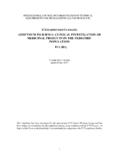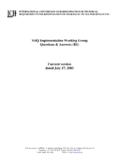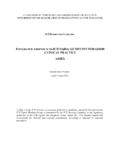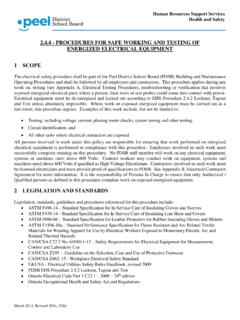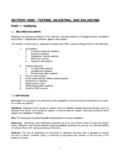Transcription of ICH HARMONISED GUIDELINE
1 INTERNATIONAL COUNCIL FOR HARMONISATION OF TECHNICAL. REQUIREMENTS FOR PHARMACEUTICALS FOR HUMAN USE (ICH). ICH HARMONISED GUIDELINE . INTEGRATED ADDENDUM TO ICH E6(R1): GUIDELINE FOR GOOD CLINICAL PRACTICE. E6(R2). Current Step 4 version dated 9 November 2016. E6(R1). Document History New First Codification History Date Codification November 2005. E6 Approval by the Steering Committee under Step 2 27 E6. and release for public consultation. April 1995. E6 Approval by the Steering Committee under Step 4 1 E6. and recommended for adoption to the three ICH May regulatory bodies. 1996. E6(R1) Step 4 version E6 Approval by the Steering Committee of Post-Step 4 10 E6(R1). editorial corrections. June 1996. Current E6(R2) Addendum Step 4 version Code History Date E6(R2) Adoption by the Regulatory Members of the ICH Assembly 9 November under Step 4. 2016. Integrated Addendum to ICH E6(R1) document.
2 Changes are integrated directly into the following sections of the parental GUIDELINE : Introduction, , , , , , , , , , , , , , , , , , (a), (b), (h), , (e), , , Legal notice: This document is protected by copyright and may be used, reproduced, incorporated into other works, adapted, modified, translated or distributed under a public license provided that ICH's copyright in the document is acknowledged at all times. In case of any adaption, modification or translation of the document, reasonable steps must be taken to clearly label, demarcate or otherwise identify that changes were made to or based on the original document. Any impression that the adaption, modification or translation of the original document is endorsed or sponsored by the ICH must be avoided. The document is provided "as is" without warranty of any kind. In no event shall the ICH or the authors of the original document be liable for any claim, damages or other liability arising from the use of the document.
3 The above-mentioned permissions do not apply to content supplied by third parties. Therefore, for documents where the copyright vests in a third party, permission for reproduction must be obtained from this copyright holder. ICH HARMONISED GUIDELINE . INTEGRATED ADDENDUM TO ICH E6(R1): GUIDELINE FOR. GOOD CLINICAL PRACTICE ICH. E6(R2). ICH Consensus GUIDELINE TABLE OF CONTENTS. 1. 1. GLOSSARY .. 2. 2. THE PRINCIPLES OF ICH GCP .. 9. 3. INSTITUTIONAL REVIEW BOARD/INDEPENDENT ETHICS COMMITTEE. (IRB/IEC) .. 10. Responsibilities .. 10. Composition, Functions and Operations .. 11. 11. Records .. 12. 4. INVESTIGATOR .. 13. Investigator's Qualifications and Agreements .. 13. Adequate Resources .. 13. Medical Care of Trial Subjects .. 14. Communication with IRB/IEC .. 14. Compliance with Protocol .. 14. Investigational Product(s) .. 15. Randomization Procedures and Unblinding.
4 15. Informed Consent of Trial Subjects .. 16. Records and Reports .. 19. Progress Reports .. 19. Safety Reporting .. 20. Premature Termination or Suspension of a Trial .. 20. Final Report(s) by Investigator .. 20. 5. SPONSOR .. 21. Quality Management .. 21. Quality Assurance and Quality Control .. 22. Contract Research Organization (CRO).. 22. Medical 23. i Integrated Addendum to E6(R1): GUIDELINE for Good Clinical Practice Trial 23. Trial Management, Data Handling, and Record Keeping .. 23. Investigator Selection .. 25. Allocation of Responsibilities .. 25. Compensation to Subjects and Investigators .. 25. Financing .. 26. Notification/Submission to Regulatory Authority(ies) .. 26. Confirmation of Review by IRB/IEC .. 26. Information on Investigational Product(s) .. 26. Manufacturing, Packaging, Labelling, and Coding Investigational Product(s) .. 27. Supplying and Handling Investigational Product(s).
5 27. Record Access .. 28. Safety 28. Adverse Drug Reaction Reporting .. 28. Monitoring .. 29. Purpose .. 29. Selection and Qualifications of Monitors .. 29. Extent and Nature of Monitoring .. 29. Monitoring 31. Monitoring 32. Monitoring Plan .. 32. Audit .. 32. Purpose .. 32. Selection and Qualification of Auditors .. 32. Auditing Procedures .. 33. Noncompliance .. 33. Premature Termination or Suspension of a Trial .. 33. Clinical Trial/Study Reports .. 33. Multicentre Trials .. 34. 6. CLINICAL TRIAL PROTOCOL AND PROTOCOL AMENDMENT(S) .. 34. General Information .. 34. Background Information .. 35. Trial Objectives and Purpose .. 35. Trial 35. Selection and Withdrawal of Subjects .. 36. Treatment of Subjects .. 36. Assessment of Efficacy .. 36. ii Integrated Addendum to E6(R1): GUIDELINE for Good Clinical Practice Assessment of Safety .. 36. 37. Direct Access to Source Data/Documents.
6 37. Quality Control and Quality Assurance .. 37. Ethics .. 37. Data Handling and Record Keeping .. 37. Financing and 37. Publication Policy .. 37. Supplements .. 37. 7. INVESTIGATOR'S 38. Introduction .. 38. General Considerations .. 38. Title Page .. 38. Confidentiality Statement .. 39. Contents of the Investigator's Brochure .. 39. Table of Contents .. 39. Summary .. 39. Introduction .. 39. Physical, Chemical, and Pharmaceutical Properties and Formulation .. 39. Nonclinical Studies .. 39. Effects in Humans .. 41. Summary of Data and Guidance for the Investigator .. 42. APPENDIX 1: .. 43. APPENDIX 2: .. 44. 8. ESSENTIAL DOCUMENTS FOR THE CONDUCT OF A CLINICAL TRIAL .. 45. Introduction .. 45. Before the Clinical Phase of the Trial Commences .. 46. During the Clinical Conduct of the Trial .. 53. After Completion or Termination of the Trial .. 59. iii INTEGRATED ADDENDUM TO ICH E6(R1): GUIDELINE FOR.
7 GOOD CLINICAL PRACTICE ICH. E6(R2). INTRODUCTION. Good Clinical Practice (GCP) is an international ethical and scientific quality standard for designing, conducting, recording and reporting trials that involve the participation of human subjects. Compliance with this standard provides public assurance that the rights, safety and well-being of trial subjects are protected, consistent with the principles that have their origin in the Declaration of Helsinki, and that the clinical trial data are credible. The objective of this ICH GCP GUIDELINE is to provide a unified standard for the European Union (EU), Japan and the United States to facilitate the mutual acceptance of clinical data by the regulatory authorities in these jurisdictions. The GUIDELINE was developed with consideration of the current good clinical practices of the European Union, Japan, and the United States, as well as those of Australia, Canada, the Nordic countries and the World Health Organization (WHO).
8 This GUIDELINE should be followed when generating clinical trial data that are intended to be submitted to regulatory authorities. The principles established in this GUIDELINE may also be applied to other clinical investigations that may have an impact on the safety and well-being of human subjects. ADDENDUM. Since the development of the ICH GCP GUIDELINE , the scale, complexity, and cost of clinical trials have increased. Evolutions in technology and risk management processes offer new opportunities to increase efficiency and focus on relevant activities. When the original ICH. E6(R1) text was prepared, clinical trials were performed in a largely paper-based process. Advances in use of electronic data recording and reporting facilitate implementation of other approaches. For example, centralized monitoring can now offer a greater advantage, to a broader range of trials than is suggested in the original text.
9 Therefore, this GUIDELINE has been amended to encourage implementation of improved and more efficient approaches to clinical trial design, conduct, oversight, recording and reporting while continuing to ensure human subject protection and reliability of trial results. standards regarding electronic records and essential documents intended to increase clinical trial quality and efficiency have also been updated. This GUIDELINE should be read in conjunction with other ICH guidelines relevant to the conduct of clinical trials ( , E2A (clinical safety data management), E3 (clinical study reporting), E7 (geriatric populations), E8 (general considerations for clinical trials), E9. (statistical principles), and E11 (pediatric populations)). This ICH GCP GUIDELINE Integrated Addendum provides a unified standard for the European Union, Japan, the United States, Canada, and Switzerland to facilitate the mutual acceptance of data from clinical trials by the regulatory authorities in these jurisdictions.
10 In the event of any conflict between the E6(R1) text and the E6(R2) addendum text, the E6(R2) addendum text should take priority. 1. 1. GLOSSARY. Adverse Drug Reaction (ADR). In the pre-approval clinical experience with a new medicinal product or its new usages, particularly as the therapeutic dose(s) may not be established: all noxious and unintended responses to a medicinal product related to any dose should be considered adverse drug reactions. The phrase responses to a medicinal product means that a causal relationship between a medicinal product and an adverse event is at least a reasonable possibility, , the relationship cannot be ruled out. Regarding marketed medicinal products: a response to a drug which is noxious and unintended and which occurs at doses normally used in man for prophylaxis, diagnosis, or therapy of diseases or for modification of physiological function (see the ICH GUIDELINE for Clinical Safety Data Management: Definitions and standards for Expedited Reporting).
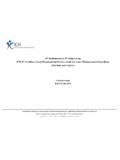
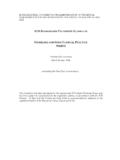
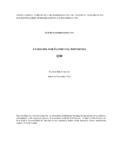

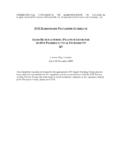
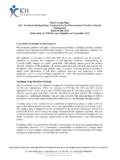
![[ICH E2F] [EXAMPLE DSUR – PHASE III …](/cache/preview/1/3/5/f/e/1/c/f/thumb-135fe1cf2cdb82799c462ad0ea089c48.jpg)
